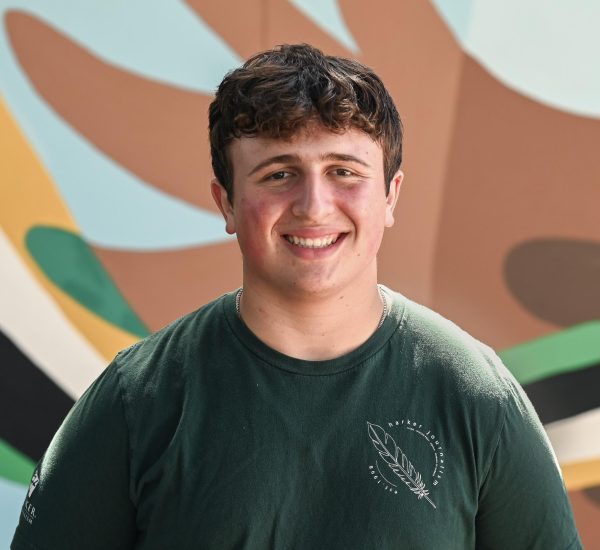Student athletes talk college sports recruiting
Upper school athletes continue their journey in sports into college
October 11, 2022

As the upper school’s fall sports season kicks off, several athletes in the senior class, who have dedicated their high school years to their sport, push their athletic journey forward — past high school and into college. For most athletes, the multi-year commitment to transitioning to collegiate sports remains a grueling, yet eventually, rewarding process.
This process begins with recruiting, in which representatives from colleges from across the country attend games and meets to scout the best high school athletes in their respective sports. These can start as early as an athlete’s sophomore year, which happened with tennis player Emily Novikov (12), who committed to Georgetown University earlier this year, and is a five-star recruit according to Tennis Recruiting Network.
“I think [recruiting] started in June of my sophomore summer,” Emily said. “That’s when schools really began talking to me, and going to my tournaments.”
When a college looks at an athlete, they begin reaching out, aiming to recruit as many of the best players as possible. Eventually, athletes who receive scholarship or prioritized entry offers consider visits to schools, and they ultimately pick between their offers to find the best fit.
Track and field runner and jumper Andrew Fu (12) began thinking about college recruiting throughout his high school years, and while the pandemic caused him to miss part of his freshman and sophomore seasons, the time off allowed him to work on his game.
“I thought to myself, maybe I can grind [track and field] over quarantine,” Andrew said. “Maybe I can get recruited to a good college. After my junior season, that’s when I started contacting coaches, seeing a lot of interests and sending transcripts. And now, schools are flying me out to see if I’d be a good fit.”
Each trip to a college campus an athlete takes is referred to as a “visit.” Some of these visits are official, like Andrew’s, and in that case, teams will fly out athletes and pay for their stay. During unofficial visits, athletes can still visit the campus, but nothing will be paid for by the university.
Offers and interests value highly in the athletic community, but sometimes, finding the right fit in a college can be more difficult than receiving the offers themselves. Varsity girls soccer player Lexi Wong (12), who committed to Pitzer College for soccer, agrees with this sentiment.
“It was really hard for me [to settle with a school],” Lexi said. “There’s not a lot of good D-3s on the West Coast. It’s super stressful, but I’m glad that I don’t have to do applications [now].”
After the process, some wish they made different decisions to make the process easier. Looking back, Emily reflects on advice she has for younger athletes.
“The biggest piece of advice I’d give is to not be afraid to reach out to coaches,” Emily said. “What do you have to lose by sending an email?”
E-mails, along with other forms of communication to coaches, like social media and text, are large parts of recruiting, as are long hours training for one’s sport. Emily highlights that communicating and attending large meets and tournaments can make the difference in recruiting.
“I was looking at D-3s when Georgetown started talking to me,” Emily said. “The coach told me to go to a big tournament; I went, and that’s where they got their best look at me. It’s just right place, right time.”




![LALC Vice President of External Affairs Raeanne Li (11) explains the International Phonetic Alphabet to attendees. "We decided to have more fun topics this year instead of just talking about the same things every year so our older members can also [enjoy],” Raeanne said.](https://harkeraquila.com/wp-content/uploads/2025/10/DSC_4627-1200x795.jpg)


















![“[Building nerf blasters] became this outlet of creativity for me that hasn't been matched by anything else. The process [of] making a build complete to your desire is such a painstakingly difficult process, but I've had to learn from [the skills needed from] soldering to proper painting. There's so many different options for everything, if you think about it, it exists. The best part is [that] if it doesn't exist, you can build it yourself," Ishaan Parate said.](https://harkeraquila.com/wp-content/uploads/2022/08/DSC_8149-900x604.jpg)




![“When I came into high school, I was ready to be a follower. But DECA was a game changer for me. It helped me overcome my fear of public speaking, and it's played such a major role in who I've become today. To be able to successfully lead a chapter of 150 students, an officer team and be one of the upperclassmen I once really admired is something I'm [really] proud of,” Anvitha Tummala ('21) said.](https://harkeraquila.com/wp-content/uploads/2021/07/Screen-Shot-2021-07-25-at-9.50.05-AM-900x594.png)







![“I think getting up in the morning and having a sense of purpose [is exciting]. I think without a certain amount of drive, life is kind of obsolete and mundane, and I think having that every single day is what makes each day unique and kind of makes life exciting,” Neymika Jain (12) said.](https://harkeraquila.com/wp-content/uploads/2017/06/Screen-Shot-2017-06-03-at-4.54.16-PM.png)








![“My slogan is ‘slow feet, don’t eat, and I’m hungry.’ You need to run fast to get where you are–you aren't going to get those championships if you aren't fast,” Angel Cervantes (12) said. “I want to do well in school on my tests and in track and win championships for my team. I live by that, [and] I can do that anywhere: in the classroom or on the field.”](https://harkeraquila.com/wp-content/uploads/2018/06/DSC5146-900x601.jpg)
![“[Volleyball has] taught me how to fall correctly, and another thing it taught is that you don’t have to be the best at something to be good at it. If you just hit the ball in a smart way, then it still scores points and you’re good at it. You could be a background player and still make a much bigger impact on the team than you would think,” Anya Gert (’20) said.](https://harkeraquila.com/wp-content/uploads/2020/06/AnnaGert_JinTuan_HoHPhotoEdited-600x900.jpeg)

![“I'm not nearly there yet, but [my confidence has] definitely been getting better since I was pretty shy and timid coming into Harker my freshman year. I know that there's a lot of people that are really confident in what they do, and I really admire them. Everyone's so driven and that has really pushed me to kind of try to find my own place in high school and be more confident,” Alyssa Huang (’20) said.](https://harkeraquila.com/wp-content/uploads/2020/06/AlyssaHuang_EmilyChen_HoHPhoto-900x749.jpeg)









